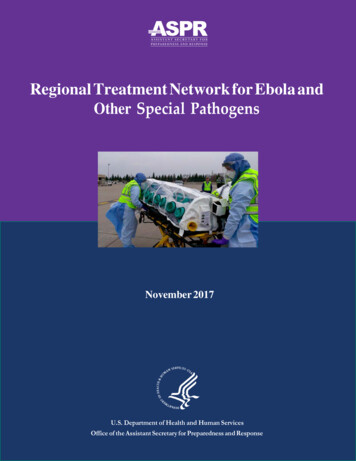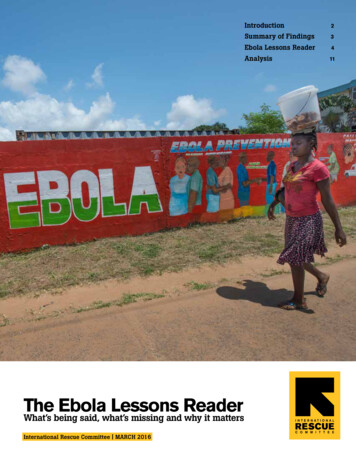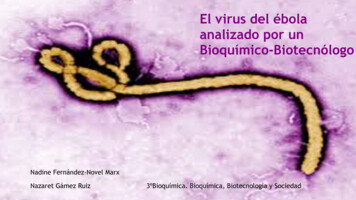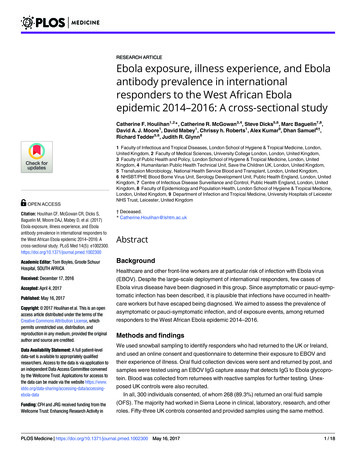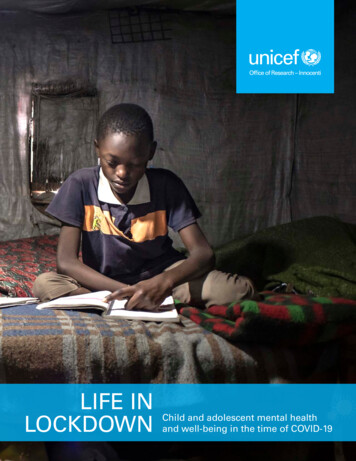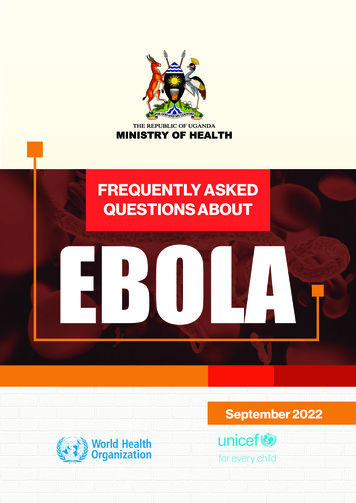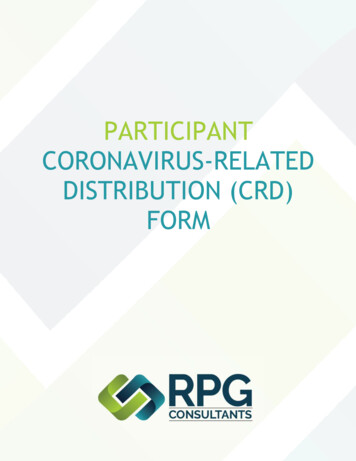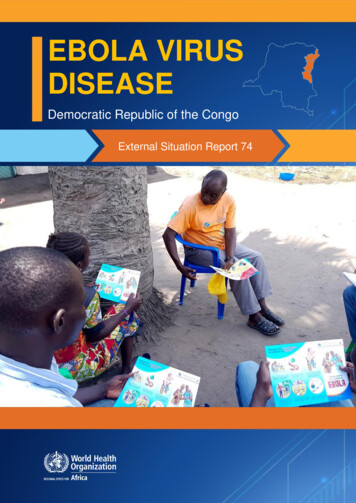
Transcription
EBOLA VIRUSDISEASEDemocratic Republic of the CongoExternal Situation Report 74Health Emergency Information and Risk AssessmentPage 1WHO Health Emergencies Programme
EBOLA VIRUSDISEASEDemocratic Republic of the CongoExternal Situation Report 74Date of issue: 7 January 2020Data as reported by: 5 January 2020Cases1. Situation update3390DeathsDeaths1002233Since the last Situation Report 73 issued on 24 December 2019, 28 new confirmed Ebola virusdisease (EVD) cases were reported from five health zones in two affected provinces in theDemocratic Republic of the Congo between 23 December 2019 to 5 January 2020. The newconfirmed cases in the past 14 days are from Butembo, Katwa, Kalunguta, Mabalako andMambasa. The source of exposure for the four new cases reported from Mambasa HealthZone, Ituri Province is currently under investigation. Mambasa Health Zone had previously nothad a confirmed case for 66 days. Similarly, the source of exposure of the initial case reportedin Kalunguta at the end of December is still under investigation.Eight of the ten cases reported in Butembo and Katwa in the past 14 days are linked to atransmission chain of more than 50 people that originated in Aloya Health Area, MabalakoHealth Zone.In the past 21 days (16 December 2019 to 5 January 2020), 42 confirmed cases werereported from 13 of the 87 health areas within five active health zones in North Kivu and Ituriprovinces (Figure 2, Table 1): Mabalako (50%; n 21 cases), Butembo (24%; n 10 cases),Kalunguta (12%; n 5), Katwa (5%; n 2) in North Kivu province and Mambasa (10%; n 4) inIturi Province.As of 5 January 2020, a total of 3390 EVD cases, including 3272 confirmed and 118 probablecases have been reported, of which 2233 cases died (overall case fatality ratio 66%). Of thetotal confirmed and probable cases, 56% (1903) were female, 28% (956) were children agedless than 18 years, and 5% (168) were healthcare workers.Health Emergency Information and Risk AssessmentPage 2WHO Health Emergencies Programme
Figure 1: Health zone of reported Ebola virus disease cases by week of illness onset,as of 5 January 2020*3390 confirmed and probable cases, reported as of 5 January 2020. Excludes n 173 cases for whom onset dates notreported. Data in recent weeks are subject to delays in case confirmation and reporting, as well as ongoing datacleaning. Other health zones include: Alimbongo, Ariwara, Beni, Biena, Bunia, Goma, Kayna, Komanda, Kyondo,Lolwa, Lubero, Mandima,, Manguredjipa, Masereka, Musienene, Mutwanga, Mwenga, Nyakunde, Nyiragongo, Oicha,Pinga, Rwampara, Tchomia, and Vuhovi.Health Emergency Information and Risk AssessmentPage 3WHO Health Emergencies Programme
Table 1: Ebola virus disease cases by classification and health zones in North Kivu and Ituriprovinces, Democratic Republic of the Congo, as of 5 January 2020CumulativeclassificationProvinceSouth KivuHealth twaKaynaKyondoNorth alHealth areasreporting atleast one casein previous 21days / totalnumber ofhealth 2/170/150/120/130/1213/471casesConfirmedcases in theConfirmed Probablelast 21 tive deathsDeathsTotal amongTotalcases confirme deathsd 005114541301711322233Note: Attributions of cases notified in recent days to a health zone are subjected to changes upon in-depth investigationsHealth Emergency Information and Risk AssessmentPage 4WHO Health Emergencies Programme
Figure 2: Geographical distribution of confirmed and probable Ebola virus disease cases by healtharea, North Kivu and Ituri provinces, Democratic Republic of the Congo, 5 January 2020*Data are subject to delays in case confirmation and reporting, as well as ongoing data cleaning and reclassification –trends during recent weeks should be interpreted cautiously.Health Emergency Information and Risk AssessmentPage 5WHO Health Emergencies Programme
2. Actions to dateThe Government and the Ministry of Health (MOH) and other national authorities in the DemocraticRepublic of the Congo, WHO, and partners are implementing outbreak control interventions togetherwith teams in the surrounding provinces, who are taking measures to ensure that they are responseready.An overview of key activities is summarized below:Surveillance and LaboratoryOver 244 000 contacts have been registered to date, and 4089 are currently under surveillanceas of 5 January 2020. On average, 87% of contacts were followed daily in the last seven days inhealth zones with continued operations.An average of 4563 alerts were reported per day over the past seven days, of which 4454(98%) were investigated within 24 hours of reporting.VaccinesFrom 8 August 2018 to 4 January 2020, 261 285 persons were vaccinated with the rVSVZEBOV-GP Ebola vaccine.Vaccination with the Ad26.ZEBOV/MVA-BN-Filo (Johnson & Johnson) vaccine continued inKarisimbi Health Zone, with 4802 people vaccinated since its introduction on 14 November2019.Case managementThere are currently 11 operational Ebola treatment centres (ETCs) and 25 Ebola transit centreslocated in the provinces of North Kivu, South Kivu and Ituri.Infection prevention and control (IPC) and Water, Sanitation and Hygiene (WASH)Water, sanitation and hygiene (WASH) activities continue, with 17 health facilities evaluated inMabalako and Butembo health zones, while 321 health workers were briefed in Oicha,Mabalako, Butembo and Mambasa as of 4 January 2020.Health Emergency Information and Risk AssessmentPage 6WHO Health Emergencies Programme
Points of Entry (PoE)During the two weeks up to 4 January 2020, 4 784 512 screenings were performed, bringingthe cumulative total to over 136 million. In these two weeks, 294 alerts were notified, of which138 (46%) were validated as suspect following investigation; none was subsequentlyconfirmed with EVD following laboratory testing. The cumulative number of EVD positivecases identified at PoEs and Points of Control (PoCs) remains at 30.The average number of PoEs and PoCs reporting daily screening has remained unchangedat 103 during the two-week period.Three high risk contacts on the move were intercepted at Maboya PoC, two on 24 Decemberand one on 26 December 2019. All contacts are linked to a confirmed EVD case reported inAloya in Mabalako Health Zone. The contact intercepted on 26 December 2019 wassubsequently referred to the Katwa ETC as a suspect case.In response to changing epidemiological trends and the recent geographical spread of theoutbreak, three mobile PoCs were established in the Biena Health Zone, and travellerscreening in surrounding areas reporting cases has been intensified. With the reintroductionof the virus in Butembo, PoCs on roads connecting Butembo and Goma are also receivingadditional support and supervision. In collaboration with the Civil Aviation Authorities, theMinistry of Health and WHO carried out a Simulation Exercise (SIMEX) for EVD on 23December 2019 at the Ndjili International Airport and Kinkole ETC in Kinshasa. The scenarioinvolved a sick air traveller landing in Kinshasa, coming from the eastern part of the country.The exercise allowed participcants to practice all actions starting from alert notification andinitial case management at the airport, all the way to the transfer of the suspect case toKinkole ETC for specimen collection and clinical management. Prior to the SIMEX, a series oftrainings, physical upgrade of the airport isolation facility and risk communications to localpopulations living around the Kinkole ETC and the general population of Kinshasa werecarried out. An evaluation of the SIMEX was conducted and a plan of action for strengtheningtraveller screening, alert and case management at, and referral from, the Ndjili Airport isunder development and will be shared with all stakeholders.Safe and Dignified Burials (SDB)As of 6 January, there have been a total of 21 840 SDB alerts notified through the Red CrossSDB database, of which 18 790 (86%) have been responded to successfully by Red Crossand Civil Protection SDB teams and community harm reduction burial teams.During the two weeks ending 6 January 2020, there were 797 SDB alerts recorded in 27health zones. Of these, 753 (94%) were responded to successfully.During this period, three health zones fell below the 70% success benchmark: Nyankunde(0%), Lolwa (69%), Nyiragongo (67%).Risk communication, social mobilization and community engagementMambasa: the team continues supporting the CREC sub commission and transferringcompetencies to the MSP team.Work is concentrated around the new confirmed cases, supporting the strengthening ofcommunity engagement and risk communication activities in the affected areas. The chief ofHealth Emergency Information and Risk AssessmentPage 7WHO Health Emergencies Programme
the chiefdom of Mambasa was on the radio calling for calm in the community and foracceptance of the consignments provided by the teams responding to EVD.Preparedness and Operational ReadinessOperational readiness in the Democratic Republic of the Congo:Readiness teams continue to implement activities without disruption in non-affected health zones(HZs) of North Kivu Province (6 HZs), Ituri Province (2 HZs), Tshopo Province (Kisangani plus 6HZs) and South Kivu Province (Bukavu plus 3 HZs).Priority 1 countriesThere have been over 2 300 alerts investigated from 39 countries and EVD was systematically ruledout in all except Uganda. Four confirmed EVD cases have been imported from Democratic Republic ofthe Congo to Uganda since June 2019, with no transmission or secondary cases in Uganda. Ugandawas successful in stopping the spread of Ebola and preventing outbreaks by investing USD 18 millionin EVD preparedness efforts. A total of 14 600 health workers have been vaccinated in the four priority1 countries (Burundi, Rwanda, South Sudan and Uganda).In South Sudan, 64 776 inbound travellers were screened through the 16 PoEs supported by IOM.Three PoEs (Isebi, Tokori and Lasu) remain out of operation due to insecurity as the situation remainsunder close monitoring. The number of inbound travellers has slightly increased by 8.7% from theprevious reporting week. The cumulative number of inbound travellers stands at 1 057 845 with no alertreported. In order to strengthen EVD surveillance and IPC in health facilities near the PoEs, IOMsupports 4 health centres (Lasu, Khorijo, Kerwa and Kaya). The IOM South Sudan EVD weekly report(week 49) is available as follows: -02-08-december-2019.In Uganda, IOM trained 30 border officials in Kasese from 9 to 11 December; these includedImmigration officials, border security, members of the District Health Team, and members of the DistrictTask Force on EVD. The training aimed at building the capacity of staff on surveillance. The IOM EVDDash Boards from the districts Kisoro, Kanungu, Rukungiri, Kasese, Rubirizi, Bundibugyo and Ntoroko,for the month of November can be found here.In Burundi, IOM supported the ministry of health to conduct a community sensitization on EVD inGatumba (Bujumbura Rural province). The sensitization was held at the Ruzizi market and reachedapproximately 800 people (38% women; 13% children) The key messages were on EVD prevention.Priority 2 countriesAngola, Central African Republic, Congo, Tanzania and Zambia have not reported any cases of EVDrelated to the Democratic Republic of the Congo outbreak to date. However, financial support forimplementing emergency preparedness activities in these countries remains insufficient to allow themto reach optimal IHR core compliance. WHO is currently providing technical support for investigationalEVD vaccination approvals and training in priority 2 countries.FinanceUnder Pillar 1, the public health pillar of the Strategic Response Plan, the estimated fundingrequirement for all partners for the period July to December 2019 is US 287 million, including US 140million for WHO. As of 5 January 2020, US 148 million have been received by WHO. We are gratefulthat donors fully funded WHO’s response needs through to the end of 2019 and into early January2020.Health Emergency Information and Risk AssessmentPage 8WHO Health Emergencies Programme
Under Pillar 5, the Regional Preparedness pillar, the funding requirement for all partners is US 66million, of which WHO requires US 21 million. As of 17 December 2019, WHO has received US 7.5million. WHO currently has no further pledges in the pipeline for preparedness. Increased funding forpreparedness in neighbouring countries is urgently needed.A summary of funding received by WHO since the start of this outbreak can be found here.Operational partnershipsUnder the overall leadership of the Government of the Democratic Republic of the Congo and insupport of the Ministry of Health, WHO is supporting public health operations and regionalpreparedness as outlined in the Strategic Response Plan. WHO is working intensively with wideranging, multisectoral and multidisciplinary national, regional and global partners and stakeholdersfor EVD response, research and preparedness.Various international organizations and UN agencies, specialized agencies and non-governmentalorganizations are involved in response and preparedness activities; the organizations and theirspecific contributions have been previously reported.WHO continues to engage the Global Outbreak Alert and Response Network (GOARN), Emergingand Dangerous Pathogens Laboratory Network (EDPLN), Emerging Disease Clinical Assessmentand Response Network (EDCARN), and the Emergency Medical Team (EMT) initiative – as well asregional operational partners and collaboration centres in Africa – to deploy experts andmultidisciplinary teams for the response, and to support intensive preparedness and readinessactivities in neighbouring and at-risk countries.WHO encourages wider coverage of partner operations via this report. If you would like to see theactivities of your agency or organization appears in the report, please send an email togoarn@who.int.IHR travel measures and cross border healthWHO advises against any restriction of travel to, and trade with, the Democratic Republic of theCongo based on the currently available information. Any requirements for certificates of Ebolavaccination are not a reasonable basis for restricting movement across borders or the issuance ofvisas for travellers to/from the affected countries. WHO continues to closely monitor and, ifnecessary, verify travel and trade measures in relation to this event. Currently, no country hasimplemented travel measures that significantly interfere with international traffic to and from theDemocratic Republic of the Congo. Travelers should seek medical advice before travel and shouldpractice good hygiene. Further information is available in the WHO recommendations forinternational traffic related to the Ebola Virus Disease outbreak in the Democratic Republic of theCongo.In order to monitor the travel and trade situation around this event, a new dashboard Ebolaoutbreak in the Democratic Republic of the Congo: Travel and trade health measures has beenestablished. The dashboard can also be accessed from Strategic Partnership for InternationalHealth Regulations (2005) and Health Security (SPH) page under ‘Resources’ tab, and then clickon ‘IHR Travel and Trade Measures’ tab. The dashboard shows all countries where WHO is awarethat travel and trade measures have been implemented, and the type of measure, and will beupdated as and when any measure is confirmed to be in place.Health Emergency Information and Risk AssessmentPage 9WHO Health Emergencies Programme
3. ConclusionNew confirmed cases continue to be reported in Mabalako, Butembo, Katwa and Kalunguta in NorthKivu Province and in Mambasa in Ituri Province and are linked to three chains of transmission. Two ofthese three chains have an unknown orgin to date and are still under investigation, including throughthe use of the genetic sequencing techniques. The new confirmed cases in Mambasa are of particularconcern, since there had been no new confirmed cases in Ituri Province for 66 days.Health Emergency Information and Risk AssessmentPage 10WHO Health Emergencies Programme
Figure 1: Health zone of reported Ebola virus disease cases by week of illness onset, as of 5 January 2020 . Health Emergency Information and Risk Assessment Page WHO Health Emergencies Programme 4 Cumulative cases by classification Cumulative deaths Province Health Zone Health areas reporting at .

